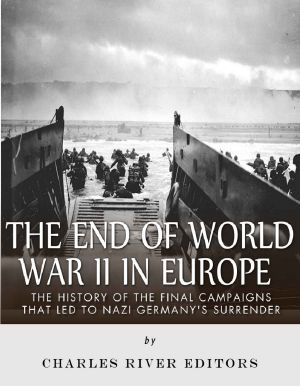The End of World War II in Europe · the History of the Final Campaigns That Led to Nazi Germany’s Surrender

- Authors
- Editors, Charles River
- Publisher
- Charles River Editors
- Date
- 2015-02-03T00:00:00+00:00
- Size
- 4.68 MB
- Lang
- en
Includes pictures
Includes accounts of the fighting by Berlin residents and Soviet soldiers
Includes footnotes and a bibliography for further reading
Includes a table of contents
“On the walls of the houses we saw Goebbels' appeals, hurriedly scrawled in white paint: 'Every German will defend his capital. We shall stop the Red hordes at the walls of our Berlin.' Just try and stop them! Steel pillboxes, barricades, mines, traps, suicide squads with grenades clutched in their hands—all are swept aside before the tidal wave.
Drizzling rain began to fall. Near Bisdorf I saw batteries preparing to open fire. 'What are the targets?' I asked the battery commander. 'Centre of Berlin, Spree bridges, and the northern and Stettin railway stations,' he answered. Then came the tremendous words of command: 'Open fire on the capital of the Fascist Germany.'
I noted the time. It was exactly 8:30 a.m. on 22 April. Ninety-six shells fell in the centre of Berlin in the course of a few minutes.” – A Soviet war correspondent
While much has been written of the Battle of the Bulge, Okinawa, Midway, Stalingrad, and many other conflicts of the Second World War, the Battle for Berlin has remained in the shadows for many historians. Its importance in toppling Hitler cannot be denied, despite the fact that some thought its strategic value unnecessary to the war itself. The capture of the city and the red Soviet banner hanging victorious over the Reichstag is one of history’s most famous (an ominous) images. In the weeks it took for the Battle of Berlin to be fought, an American president passed away, a British Prime Minister had to make concessions he did not desire, a Russian leader fought his way into Western Europe to stay, and a German one took his own life. The battle’s implications would be felt for the next 50 years.
In April 1945, the Allies were within sight of the German capital of Berlin, but Hitler refused to acknowledge the collapsed state of the German military effort even at this desperate stage, and he confined himself to his Berlin bunker where he met for prolonged periods only with those that professed eternal loyalty, even to the point of death. In his last weeks, Hitler continued to blame the incompetence of military officers for Germany’s apparent failings, and he even blamed the German people themselves for a lack of spirit and strength. As their leader dwelled in a state of self-pity, without remorse or mercy but near suicide, the people of Berlin were simply left to await their fate as Russians advanced from the east and the other Allies advanced from the west.
Most Berliners had given up hope of a win, and few cared for anything but relief from their circumstances, but Berliners did have a deep fear of which of the victor nations would arrive in Berlin first. The Soviets, closing in from hard fought battles in the east, had lost millions of men in the war already, and with an invasion force 2.5 million strong, they longed for revenge and a chance to right the wrongs of not only this war but the last. Even for Berliners too exhausted to be saddened by a German loss, “liberation” by the Soviets was unthinkable. At the same time, though most believed it would not happen, the Americans and British suddenly appeared to shift priorities regarding the need to take the actual capital city. Since it was “no longer a military objective”, according to Eisenhower, it would be left for the Soviet armies to arrive in Berlin first, bringing to fruition many Germans’ worst fears.
The battle would technically begin on April 16, 1945, and though it ended in a matter of weeks, it produced some of the war’s most climactic events and had profound implications on the immediate future.